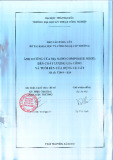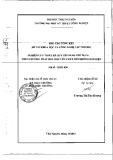
Effects
of
winter
on
genetic
structure
of
a
natural
population
of
Drosophila
melanogaster
C.
BIÉMONT
Biologie
des
Populations,
Université
Lyon
1,
F
69622
Villeurbanne
Summary
A
natural
population
of
Drosophila
melanogaster
from
a
cellar
was
followed
throughout
the
year
and
its
genetic
structure
analysed
by
a
sib-mating
approach
(based
on
distributions
of
viability
ratio in
sib-mating
offspring)
and
enzymatic
polymorphism.
Flies
found
early
in
spring,
that
had
resisted
cold
temperature
and
food
shortage
during
winter,
were
free
of deleterious
factors ;
no
inbreeding
depression
was
observed
in
the
viability
of
their
immediate
descendants.
In
contrast,
a
population
established
during
winter
in
a
bucket
of
ripe
fruit
placed
in
the
cellar,
showed
a
high
frequency
of
lethals.
In
both
cases,
the
increasing
effective
size
that
followed
the
return
of
a
favorable
environment
was
associated
with
an
inbreeding
depression
in
further
generations.
The
collected
flies
were
highly
heterozygous
at
enzyme
loci,
although
the
pattern
was
perturbed
by
drift
and
sampling
error.
The
genetic
structure
of
the
populations
may
thus
depend
not
only
on
effective
popu-
lation
size
but
also
on
selection
favoring
heterozygotes
either
free
of
or
bearing
lethals
(according
to
the
conditions
encountered).
The
observation
of
an
annual
cycle
of
change
in
enzymatic
and
deleterious
allele
frequencies,
and
degree
of
heterozygosity,
depends
then
on
when
and
how
flies
are
collected.
Key
words :
Natural
population,
genetical
structure,
inbreeding,
natural
selection,
D.
melanogaster.
Résumé
Effets
de
l’hiver
sur
la
structure
génétique
d’une
population
naturelle
de
Drosophila
melanogaster
Une
population
naturelle
de
Drosophila
melanogaster
d’une
cave
fut
suivie
tout
au
long
d’une
année.
Sa
structure
génétique
fut
approchée
par
l’analyse
de
la
viabilité
après
croisements
frère-sceur
(une
mesure
du
« fardeau
génétique »)
et
le
polymorphisme
enzy-
matique.
Les
mouches
de
printemps
qui
avaient
résisté
à
l’hiver,
n’avaient
pas
de
gènes
létaux.
La
fréquence
de
ces
gènes
augmentait
cependant
rapidement
avec
l’effectif
de
la
population
pour
atteindre
une
valeur
d’équilibre
dans
les
populations
d’été
et
d’automne.
Par
contre,
la
fréquence
des
gènes
létaux
était
forte
dans
une
population
maintenue
pendant
l’hiver
sur
des
fruits
placés
dans
la
cave.
On
conclut
que
la
structure
génétique
de
ces
populations
doit
dépendre
non
seulement de
leur
taille
effective
mais
aussi
de
la
sélection

naturelle
favorisant
les
individus
hétérozygotes
pour
les
loci
enzymatiques;
ces
individus
portaient
ou
ne
portaient
pas
de
gènes
létaux
selon
l’environnement
auquel
était
soumise
la
population.
L’observation
d’un
cycle
annuel
de
variation
de
fréquence
des
gènes
enzy-
matiques
et
délétères,
ainsi
que
du
degré
d’hétérozygotie,
doit
alors
dépendre
du
moment
et
de
la
manière
dont
les
mouches
sont
collectées.
Mots
clés :
Population
naturelle,
structure
génétique,
consanguinité,
sélection
naturelle,
D.
melanogaster.
1.
Introduction
The
role
of
selection
for
heterozygotes
in
maintaining
the
genetic
variability
of
populations
is
one
of
genetic’s
most
intriguing
problems.
Though
some
works
suggest
that
highly
heterozygous
individuals
enjoy
an
enhanced
developmental
homeostasis,
which
enable
them
to
adjust
their
development
and
physiological
processes
in
res-
ponse
to
environmental
challenge
(L
ERNER
,
1954),
the
mechanisms
which
determine
a
population’s
genetic
structure
remain
obscure
(see
L
EW
O
NT
IN,
1974,
for
a
review).
One
of
the
theories
to
emerge
from
observations
on
genetic
variability
in
populations
of
Drosophila
is
the
proposal
that
extreme
environmental
conditions
favor
heterozy-
gous
individuals
(see
P
ARSONS
,
1983,
for
a
review).
But
it
is
not
clear
whether
these
heterozygotes
harbor
lethal
alleles
(G
OLUSUVSKY
,
1970 ;
L
EWONTIN
,
1974)
or
are
free
of
lethals
(B
AND
,
1963 ;
B
AND
&
Y
VES
,
1961,
1968 ;
H
IRAIZUMI
&
C
ROW
,
1960 ;
MUKAI
&
YAMAGUCHI,
1974).
The
deleterious
gene
frequencies
in
natural
populations
can
fluctuate
in
res-
ponse
to
environmental
events
which
affect
population
size.
The
same
environmental
events
can
select
for
or
against
heterozygous
individuals
and
may
or
may
not
be
followed
by
inbreeding
depression.
Hence,
the
proposal
that
Drosophila
melanogaster
demonstrates
cyclic
changes
in
deleterious
gene
frequencies
due
to
various
and
ex-
treme
climatic
conditions
encountered
every
year,
largely
depends
on
spatial
and
temporal
structure
of
the
population.
For
instance,
selection
for
heterozygotes
free
of
lethals
might
be
observed
only
if
the
flies
were
caught
just
before
the
effective
size
of
the
population
expands
and
becomes
large
enough
for
lethals
to
accumulate.
An
important
point
is
that
the
genetic
techniques
most
often
used
to
compare
the
homozygous
and
heterozygous
effects
of
deleterious
genes
or
gene
complexes
in-
volve
making
chromosomes
totally
homozygous
(L
EWONTIN
,
1974).
However,
it
has
been
shown
recently
that
certain
mutations
and
lethals
observed
in
natural
popu-
lations
are
the
result
of
interactions
between
the
wild
strain
studied
and
the
marker
strain
used
(K
IDWELL
,
1983 ;
B
REGL1
AN0 8i
al.,
1980).
Note
also
that
the
general
method
of
producing
homozygous
chromosomes
is
an
inbred
mating
system
(generally
between
brothers
and
sisters),
so
that,
in
addition
to
the
chromosomes
being
studied,
the
entire
genome
is
rendered
more
homozygous
(LEW
ON
TI
N,
1974).
As
a
result
one
cannot
distinguish
the
effects
of
homozygosity
of
a
particular
chromosome
from
a
general
increase
in
homozygosity
of
the
background
genotype.
In
order
to
eliminate
this
problem,
a
different
approach
has
been
adopted.
The
approach
involves
studying
the
distribution
of
viability
of
offspring
of
sib
matings
(B
IÉ
MONT
,
1983 ;
BIÉ
MONT
&
BOUCLIER,
1983).
This
paper
reports
the
results
of
sib-mating
analysis
in
association
with
a
survey
of
enzymatic
polymorphism
of
a
cellar
population
of
Drosophila
melanogaster.
The

study
concerns
the
population’s
genetic
makeup
in
winter,
during
which
harsh
en-
vironmental
conditions
severely
reduced
the
population
size,
and
in
early
spring
where
a
few
flies
may
survive
to
found
a
new
population.
IL
Material
and
methods
A.
Collection
site
Flies
were
collected
from
a
cellar
in
Valence
(Drome,
France).
The
cellar
mea-
sured
4
by
4
meters
with
a
dirt
floor.
Migrant
flies
apparently
may
enter
and
leave
via
a
small
window.
Though
many
different
kinds
of
fruit
are
stored
in
this
cellar
through
the
year,
no
fruit
remained
available
during
the
winter
period
from
De-
cember
to
the
beginning
of
June
when
the
first
fruit
appears.
Initial
collection
trips
to
the
vacant
cellar,
from
December
1981
through
the
following
April,
were
un-
rewarding.
It
was
not
until
early
May
1982
that
2
Drosophila
melanogaster
females
were
first
captured.
They
were
found
to
have
been
fertilized
prior
to
capture
so
that
their
brother
and
sister
offspring
were
analysed
for
viability
(fraction
of
the
fertilized
eggs
which
develops
to
the
adult
stage).
The
progeny
of
one
of
thèse
wild
females,
arbitrarily
chosen,
was
maintained
in
the
laboratory
so
that
the
genetic
structure
of
her
non
overlapping
descendant
generations
could
be
analysed.
This
population
is
identified
as
the
« isofemale
population ».
In
June,
cherries
and
strawberries
were
stored
in
the
cellar
and
a
Drosophila
population
expanded
rapidly.
In
each
of
June,
September
and
October,
a
sample
of
about
50
females
was
taken
from
the
cellar
and
laboratory
populations
established
from
their
offspring.
The
F2
of
these
females
were
first
analysed
in
order
to
avoid
possible
influence
of
the
environment
under
which
the
mothers
had
undergone
development.
The
established
populations
were
then
ana-
lysed
again
a
few
generations
later.
In
November
1982,
at
a
time
where
the
flies
usually
disappear,
an
experimental
«
natural
» population
was
set
up
by
putting
some
ripe
apples
and
pears
in
a
bucket
inside
the
cellar.
The
population
of
Drosophila
which
established
in
the
bucket
was
undisturbed
for
4
months.
The
minimum
temperature
of
the
cellar
during
this
pe-
riod
was
10 °C ;
the
temperature
inside
the
bucket
was
not
determined.
A
sample
of
the
population
was
taken
in
February
1983
and
the
F2
flies
analysed.
Also,
a
« Fe-
bruary
» population
was
established
in
the
laboratory
(from
about
50
females)
and
maintained
in
bottles
by
tipping
over
large
number
of
parents
in
each
generation.
The
flies
were
reared
in
the
laboratory
on
a
standard
axenic-dried
yeast-agar
medium
at
25 °C
in
the
dark.
B.
The
sib-mating
analysis
Genetic
variability
in
species
that
lack
genetic
markers,
is
classically
evaluated
by
comparing
effects
of
various
inbred
crosses
on
average
viability.
This
method
assumes
a
linear
relationship
between
the
intensity
of
inbreeding
depression
and
the
theoretical
value
of
the
inbreeding
coefficient.
The
assumptions
made
in
this
model
are
not
always
met,
and
their
biological
meanings
have
been
largely
debated
and

criticized
(see
for
example
L
EWONTIN
,
1974).
The
following
approach
involves
stu-
dying
the
distributions
of
viability
values
of
sib-mating
offspring.
This
method
can
then
be
used
in
species
that
lack
adequate
genetic
markers
and
it
is
free
of
biological
assumptions
about
the
nature
of
lethality.
For
all
the
populations,
50
males
and
50
females
were
chosen
at
random
from
either
the
F2
offspring
or
the
established
laboratory
populations.
The
flies
were
then
crossed
in
pairs.
The
pairs
so
formed
were
set
up and
allowed
to
lay
eggs.
50
eggs
laid
by
each
mated
female
were
transferred
to
a
vial
with
fresh
medium
to
allow
FI
progeny
to
develop.
The
F,
adults
emerging
from
the
eggs
were
counted.
Egg
viability
for
each
pair
of
these
controls
was
then
estimated
by
calculating
the
per-
centage
of
fertilized
eggs
that
produced
adults.
At
hatching
time,
one
brother-sister
F,
pair
for
each
progeny group
was
separated
and
allowed
to
mate.
The
eggs
laid
during
2
successive
periods
of
10
h
each,
were
collected.
Replicate
samples
of
50
eggs
from
each
lot
were
then
transferred
to
new
vials
where
F2
progeny
developed.
The
F2
adults
emerging
from
each
replicate
lot
were
counted
and
viability
ratios
were
de-
termined.
The
data
from
replicates,
found
to
be
homogeneous
by
chi-square
tests,
were
pooled.
These
data
lead
thus
to
viability
distribution
curves
for
control
and
sib
generations.
Note
that
the
first
descendant
of
each
of
the
wild
female
collected
in
May
are
all
sibs.
The
offspring
viability
was
analysed
on
about
50
brother-sister
pairs
for
each
progeny.
C.
Electrophoresis
A
sample
of
50
males
from
each
population
and
some
laboratory
generations
was
analysed
by
standard
horizontal
starch
gel
electrophoresis.
The
loci
were
run
on
a
tris-citrate
buffer
system
(P
OULIK
.
1957)
and
stain
on
the
same
gel.
Five
enzymatic
loci
were
examined :
alcohol
dehydrogenase
(Adh),
alpha-glycerophosphate
dehydro-
genase
(a-Gpdh),
Esterase-6
(Est-6),
Esterase-C
(Est-C)
and
phosphoglucomutase
(PGM).
The
staining
methods
were
those
of
G
IRARD
(1976).
D.
Numerical
analysis
Distributions
of
viability
values
The
distributions
of
viability
values
were
analysed
globally
by
a
correspondence
factorial
analysis
(B
ENZECRI
,
1973).
This
method
of
ordination
allows
depiction
of
the
different
populations
that
are
characterized
by
the
pattern
of
distribution
of
their
viability
values.
Each
population
is
defined
by
its
position
in
a
space
of
as
many
di-
mensions
as
the
number
of
classes
of
viability
values.
Distances
between
2
popula-
tions
are
then
measured
by
a
chi-square
metric.
The
aim
of
the
analysis
is
to
find
the
maximum
variability
axes
of
the
variance-covariance
matrix.
Hence,
the
graph
distance
between
any
2
populations
is
a
measure
of
their
similarity
for
viability
dis-
tribution.
This
factorial
analysis
takes
account
of
all
the
information
contained
in
the
distribution
curves.
It
is
then
much
more
powerful
in
determining
differences
between
populations
than
a
viability
index
based
on
average
values.

Electrophoresis
data
Using
the
allelic
frequency
data,
the
within-population
fixation
index
(FIS
)
was
calculated
for
each
polymorphic
enzyme
locus,
where
Ho
is
the
observed
proportion
of
hete-
rozygotes
and
He
is
the
expected
Hardy-Weinberg
proportion.
A
positive
value
of
F
ls
indicates
an
excess
of
homozygotes.
F
is
, the
mean
fixation
index
for
a
population
over
all
loci,
represents
the
average
deviation
of
the
population’s
genotypic
propor-
tions
from
the
Hardy-Weinberg
equilibrium
due
to
the
combined
effects
of
finite
population
size,
selection,
inbreeding,
and
other
forces
affecting
the
genetic
makeup
of
the
population.
To
test
whether
the
values
of
F
ls
represent
significant
deviations
from
panmixia,
a
one-tailed
chi-square
test
was
used
according
to
the
formula
of
Li
&
H
ORVITZ
(1953).
X2
=
F
IS
N;
(k- 1)
with
k(k- 1)/2
degrees
of
freedom,
with
N;,
sample
size
and
k,
number
of
alleles.
Since
this
x=
is
the
same
as
the
one
calculated
directly
from
the
observed
and
expected
genotypic
frequencies,
F
IS
was
tested
for
signifi-
cance
by
a
summation
of
all
the
individuals
X2
associated
with
each
locus.
The
re-
m
sulting
X2
has
then 1
k;
(k
;
- 1)/2
degrees
of
freedom,
with
m,
number
of
loci
in
i =
1
the
population.
III.
Results
A.
Distributions
of
viability
values
The
distributions
of
the
viability
ratios
are
shown
in
figures
1
and
2.
In
general
the
curves
appear
heterogeneous
in
that
we
can
distinguish
2
groups
of
pairs :
those
with
high
viability
values
equal
or
above
0.90
and
those
with
viability
values
less
than
0.90.
It
can
be
easily
seen
that
the
brother-sister
crosses
produced
consistently
a
smaller
proportion
of
viable
offspring
than
did
control
crosses.
These
sib
matings
result
also
in
a
wide
scatter
of
viability
values
leading
thus
to
a
trend
towards
low
values.
These
distribution
patterns
reflect
the
expression
of
deleterious
factors
due
to
the
increased
homozygosity
of
the
genome
in
the
offspring
from
the
sib
pairs
(L
E
worrTrrr,
1974 ;
BIÉ
MONT
,
1983).
Thus,
the
comparison
of
populations
and
genera-
tions
on
the
basis
of
the
distributions
of
the
viability
ratios
reflect
the
amount
of
deleterious
factors
those
populations
concealed.
For
such
comparison,
the
distribu-
tions
were
analysed
by
a
correspondence
factorial
analysis
(B
ENZECRI
,
1973).
Gra-
phical
representation
of
the
results
of
this
statistical
analysis
is
shown
in
figure
3.
The
analysis
separates
the
controls
from
the
sib-matings
as
a
function
of
the
proportion
of
high
viability
batches.
The
wide
scatter
of
the
sib-mating
progenies
on
the
left
part
of
the
plane
results
from
their
trends
towards
low
viability
values.


























